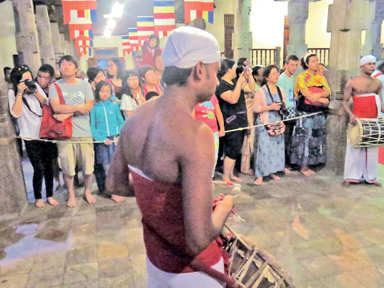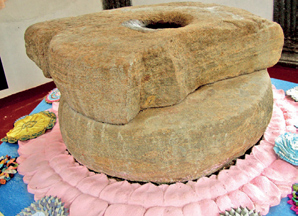Esala, when Kandy dazzles
Story and pictures by Mahil Wijesinghe
|

The front view of the temple of the Sacred Tooth Relic with
the Pattirippuwa |
Kandy is always an exciting place, bustling with activity and exuding
a spiritual mien. It is more so during the Esala season. Tourist
brochures, travel magazines, even ordinary articles feature Kandy as a
top heritage tourist spot for visitors and the most widely photographed
place in Sri Lanka.
Every day, from dawn to dusk, the chanting in the Temple of the
Sacred Tooth can be heard, even as devoted pilgrims and visitors
reverently make their way in, with lotus flowers in their hands, to pay
homage to the Sacred Tooth Relic.
Kandy is my regular destination for pilgrimage and photographic
expeditions. Each time I visit Kandy, my first priority is to pay homage
to the sacred Tooth Relic of the Buddha, guarded at the temple for
centuries.
Each year, during the month of Esala (July/August), everyone's
attention is on Kandy, because of the annual Esala Perahera, one of the
most spectacular and awe inspiring pageants that attract visitors like a
giant magnet. During this time, the already crowded Kandy too overflows
with local and foreign tourists alike, all eager to witness the grand
spectacle.
Reputation
But this grand city is not only about the Sacred Tooth Relic. Kandy,
which earned the reputation of being the last Sinhala Kingdom that kept
the foreign invaders at bay for nearly 500 years, also has its historic
appeal. The Kings of Kandy ensured the safety and sovereignty of the
hill capital and its great culture, until the city was finally captured
by the British in 1815.
|

The Hevisi Thevava |
|

The maize grinding stone at Delgamuwa Vihare where the Tooth
Relic was hidden from Portuguese invaders |
Kandy was originally known as Senkadagala, named after a hermit
Senkanda, who lived there. To many, it is known as Maha Nuwara. But the
name Kandy was derived from the word 'Kanda', which means mountain, an
ideal name for a city 500 metres above sea level, surrounded by the
Knuckles, Dolosbage and Kotmale mountain ranges, and accessible only by
a series of steep roads and the railway.
The Dalada Maligawa or the Temple of the Sacred Tooth Relic, one of
the most striking features of Kandy, is located in the heart of the
adjoining a beautiful Kandy lake. It is undoubtedly the most venerated
Buddhist shrine in the world and is one of Sri Lanka's seven UNESCO
World Heritage sites.
History records that the Sacred Tooth Relic of the Buddha, which was
preserved in Kalinga in India after the passing away of the Buddha, was
brought to Sri Lanka during the period of King Kirthi Sri Meghavanna
(301-328).
According to historical accounts, when Kalinga was deemed not safe
for the Relic, Prince Dantha and Princess Hemamala, two Kalinga royals
had arrived in to Sri Lanka with the Relic cleverly concealed in
Princess Hemamala's hair. They had landed in Lankapatana near
Trincomalee, proceeded to Anuradhapura and handed over the Relic to King
Meghavanna. It was originally deposited with high veneration at the
present Isurumuniya temple and was later moved to a special site built
in the centre of Anuradhapura city.
Ever since, the protection of the Sacred Tooth Relic was considered
the prime responsibility of the rulers and was symbolic of authority to
rule the country. However, it travelled with Kings from Anuradhapura to
Polonnaruwa, Dambadeniya, Yapahuwa and to Kurunegala, and was
accommodated always in a special shrine built close to the royal palace.
During the Gampola rule (1341-1412) it was kept at a temple called
Niyangampaya and later moved to Jayewardenepura Kotte, when the capital
moved there.
Due to invasions, the Sacred Tooth Relic, which was once hidden
inside a maize grinding stone in an ancient temple called Delgamu Vihare
at Kuruwita, Ratnapura, was brought to Kandy by King Wimaladharmasuriya
I, second dynasty of Kings of Kandy (1592-1604). The Relic was deposited
in a special two storeyed temple erected in close proximity to the royal
palace.
Guardian monks
The original Kandy Dalada Maligawa, which was destroyed by the
Portuguese who invaded Kandy in 1603, was built in 1592 during the reign
of King Wimaladharmasuriya I. When the temple was destroyed, the
guardian monks fled with the Relic to Medamahanuwara in Dumbara. Later
King Rajasinghe II (1629-1687) re-constructed the Temple of the Tooth.
King Wimaladharmasuriya II (1687-1707) constructed the three storeyed
temple as a shrine to accommodate the Sacred Relic.
King Sri Vira Prakrama Narendrasinha (1707-1739) had also constructed
a two storeyed building for the same purpose. The imposing octagonal
Pattirippuwa, adjoining the Dalada Maligawa was added by the King Sri
Wickrema Rajasinha (1798-1815), the last King of Sri Lanka.
The painted ceilings, wood carvings, silver and ivory doors are the
architectural highlights of the Maligawa. The two-storeyed temple with
carved timber column beams and rafters, and the roof is covered with
cool clay tiles and motifs of Bo-leaf eaves.
|

Painted ceiling with elaborate floral motifs |
The Tooth Relic has remained in the inner chamber of the temple.
Devotees are allowed to worship during a limited period in the mornings
and evenings. The rituals, which are known as 'Thevava' are conducted
daily following traditions since the Relic was brought to Sri Lanka. The
Malwatte and Asgiriya monasteries located elsewhere in Kandy take turns
in conducting the rituals in the Maligawa.
Moreover, a 'Hevisi Thevava' is performed daily in Hevisi Mandapaya
at the Dalada Maligawa. Foreigners visiting the Maligawa when the Hevisi
Thevava is being performed, are fortunate enough to witness the drum
beatings and rituals.
|

The original stone carvings of the Maligawa, which were
damaged by the bomb blast in 1998 |
During the terrorist attack on the Dalada Maligawa in 1998, the outer
structure was severely damaged. It was restored to its original
condition soon after the attack.
The original stone carvings at the entrance to the Maligawa, which
were damaged by the blast, have been restored and now located near the
Royal Palace.
Most visitors to the Dalada Maligawa make it a point to pay homage to
Maligawa Raja who died in 1988 at the age of 75.
His treated remains lie in a special museum in the temple premises.
Raja has participated as the chief tusker at the annual Esala Perahera
in Kandy for around 50 years and was the sacred casket bearer of the
final Randoli Perahera for 37 years. Raja has been named as a national
treasure in recognition of his valuable services to religion and
culture.
The grand cultural pageant of the annual Esala Perahera, initiated to
pay homage to the Sacred Tooth Relic, is thought to have originated in
1775 under the reign of King Kirthi Sri Rajasinha. Today, it is the best
among of the country's peraheras.
Taking place every year in July/August, the perahera wends its way
along the streets of Kandy every day for ten days, creating a living
tapestry of magic.
Dozens of richly caparisoned elephants; grandly attired Nilames,
custodians of the Maligawa and Devales), hundreds of ornamented Kandyan
dancers; and hundreds of drummers beating stomach-wrenching throbs
create a spectacle that draws thousands from all parts of the world
every year. |

